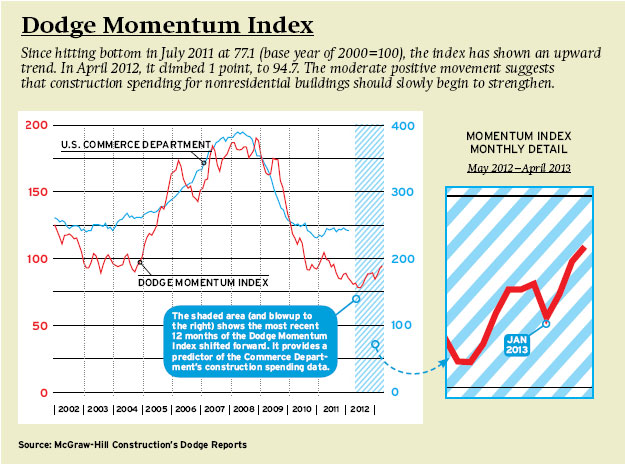The Construction Chart Book: The US Construction Industry and Its Workers 5th Edition, (2013), a free download, is a valuable resource for building product executives. Published by The Center for Construction Research and Training*, it is a trove of information about construction industry
employment demographics and trends. While most useful, perhaps, for economists, insurance companies, safety officers, and policy makers, it contains nuggets that can help you digest new product opportunities and paths to market.
Consider the following from the Main Findings of the report, with my comments:
About 80% of construction payroll establishments had 1 to 9 employees.
You surely don't have time to send sales reps to these small firms, so your marketing communication or distributors better find a way to reach them.
About 12% of construction firms used day laborers; 22% of employer firms had no full-time employees on their payroll, and 8% hired temporary workers through temporary agencies.
With a transient work force, you better support your customer by offering products that are simple to use and hard to screw up, and training programs that can be given quickly on the job site.
Construction employment is expected to grow by 1.84 million wage-and-salary jobs, or 33%, between 2010 and 2020, more than double the 14% growth rate projected for the overall economy.
Where will all those new employees come from? Beyond normal efforts to build brand awareness among newcomers to the industry, manufacturers should also consider ways to recruit the new work force by training them and creating networks to connect trained installers to potential employers among your customer base. I wonder, however, what effect robotics and construction automation will have on this trend; perhaps not much within 5 years... but after that?
About 2 million construction workers in 2010 were born in foreign countries.
What can you do to transfer brand loyalty across borders?
More than 75% of Hispanic construction workers were born outside the United States.
Your product labels, installation instructions, advertising, and field representatives may need to be bilingual.
Between 1985 and 2010, the average age of construction workers jumped from 36.0 to 41.5 years old.
At some point, the trend will reverse. Are you able to communicate with digital natives?
Union members in construction have advantages in educational attainment, wage and fringe benefits, training, and longer employment tenures, compared with non-union workers.
Look for opportunities to partner with unions for training, etc.
The number of fatal injuries in construction dropped to 802 in 2010 from the peak of 1,297 in 2006. The decrease in recent years was mainly due to the decline in construction employment during the economic downturn.
In other words, fatalities haven't significantly decreased. Everyone in our industry has a moral obligation to improve safety. How can your product, its packaging, the tools required to install it, etc, create a safer workplace? Make the contractor's chief safety officer your ally.
In 2010, overexertion in lifting caused 38% of the work-related musculoskeletal disorders among construction workers.
Lighter weight material? Improved packaging? Simplified lifting and installation procedures? These are important product enhancements.
* Published by CPWR – The Center for Construction Research and Training, produced with support from the National Institute for Occupational Safety and Health grant number OH009762.
Consider the following from the Main Findings of the report, with my comments:
About 80% of construction payroll establishments had 1 to 9 employees.
You surely don't have time to send sales reps to these small firms, so your marketing communication or distributors better find a way to reach them.
About 12% of construction firms used day laborers; 22% of employer firms had no full-time employees on their payroll, and 8% hired temporary workers through temporary agencies.
With a transient work force, you better support your customer by offering products that are simple to use and hard to screw up, and training programs that can be given quickly on the job site.
Construction employment is expected to grow by 1.84 million wage-and-salary jobs, or 33%, between 2010 and 2020, more than double the 14% growth rate projected for the overall economy.
Where will all those new employees come from? Beyond normal efforts to build brand awareness among newcomers to the industry, manufacturers should also consider ways to recruit the new work force by training them and creating networks to connect trained installers to potential employers among your customer base. I wonder, however, what effect robotics and construction automation will have on this trend; perhaps not much within 5 years... but after that?
About 2 million construction workers in 2010 were born in foreign countries.
What can you do to transfer brand loyalty across borders?
More than 75% of Hispanic construction workers were born outside the United States.
Your product labels, installation instructions, advertising, and field representatives may need to be bilingual.
Between 1985 and 2010, the average age of construction workers jumped from 36.0 to 41.5 years old.
At some point, the trend will reverse. Are you able to communicate with digital natives?
Union members in construction have advantages in educational attainment, wage and fringe benefits, training, and longer employment tenures, compared with non-union workers.
Look for opportunities to partner with unions for training, etc.
The number of fatal injuries in construction dropped to 802 in 2010 from the peak of 1,297 in 2006. The decrease in recent years was mainly due to the decline in construction employment during the economic downturn.
In other words, fatalities haven't significantly decreased. Everyone in our industry has a moral obligation to improve safety. How can your product, its packaging, the tools required to install it, etc, create a safer workplace? Make the contractor's chief safety officer your ally.
In 2010, overexertion in lifting caused 38% of the work-related musculoskeletal disorders among construction workers.
Lighter weight material? Improved packaging? Simplified lifting and installation procedures? These are important product enhancements.
* Published by CPWR – The Center for Construction Research and Training, produced with support from the National Institute for Occupational Safety and Health grant number OH009762.














